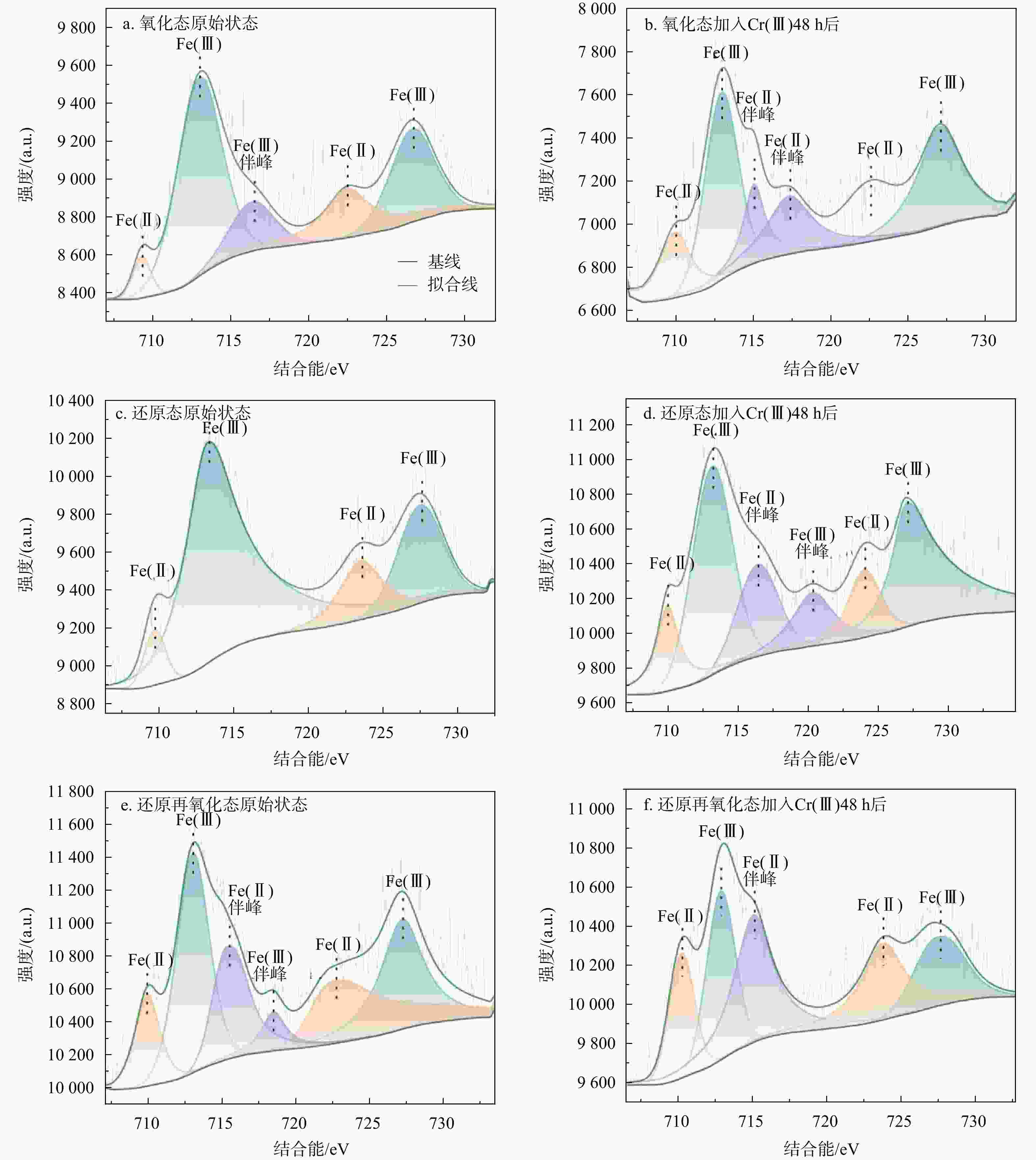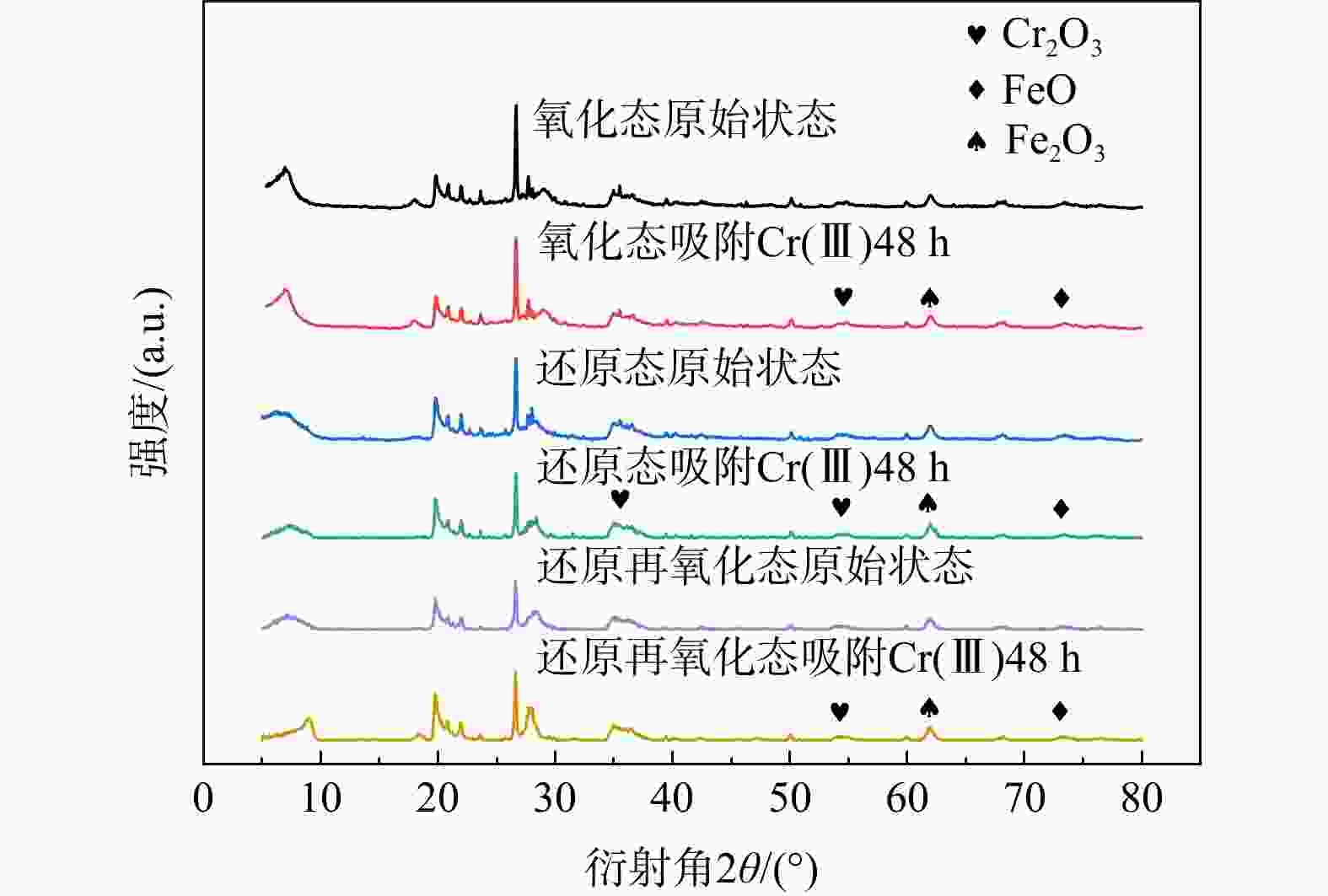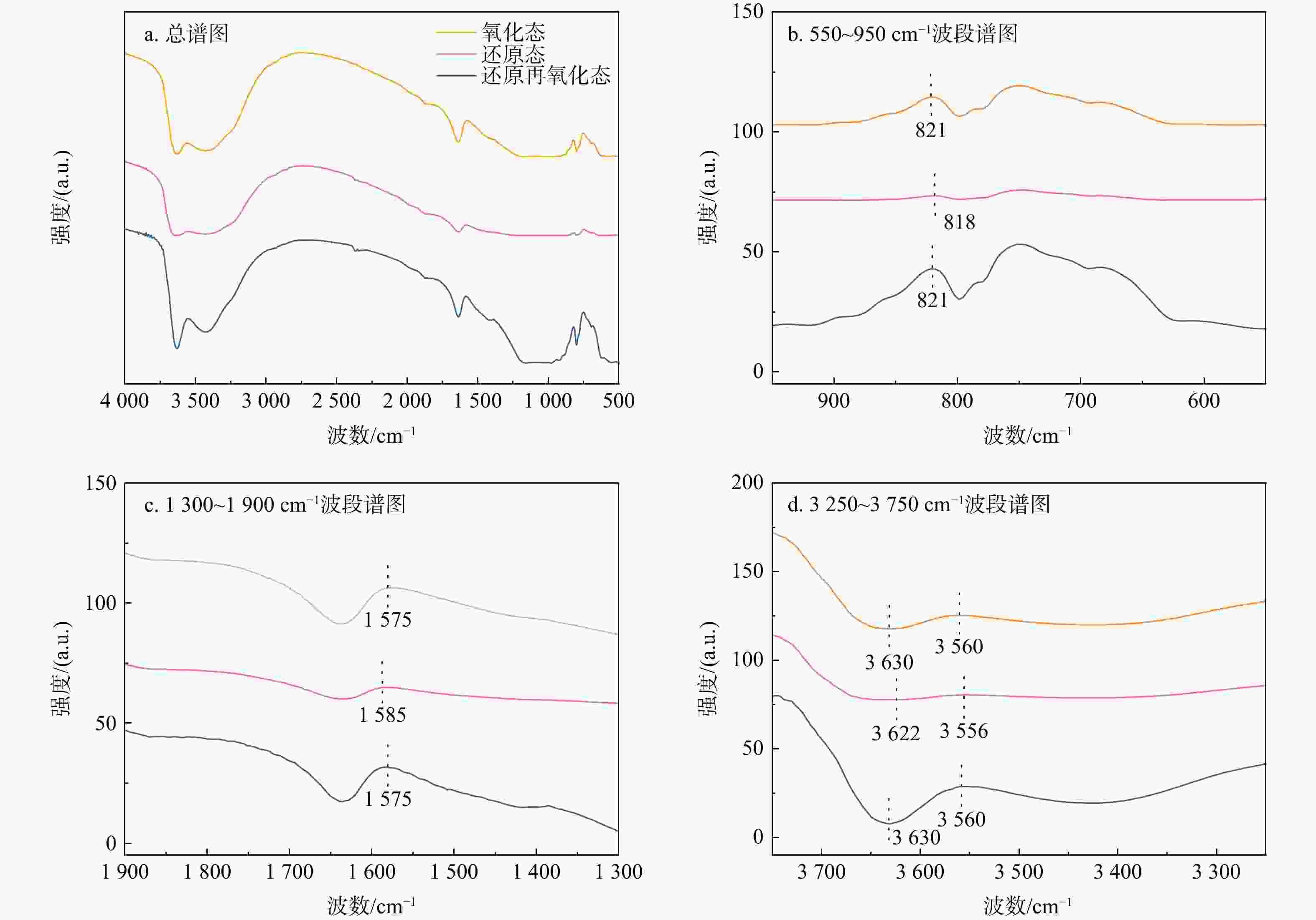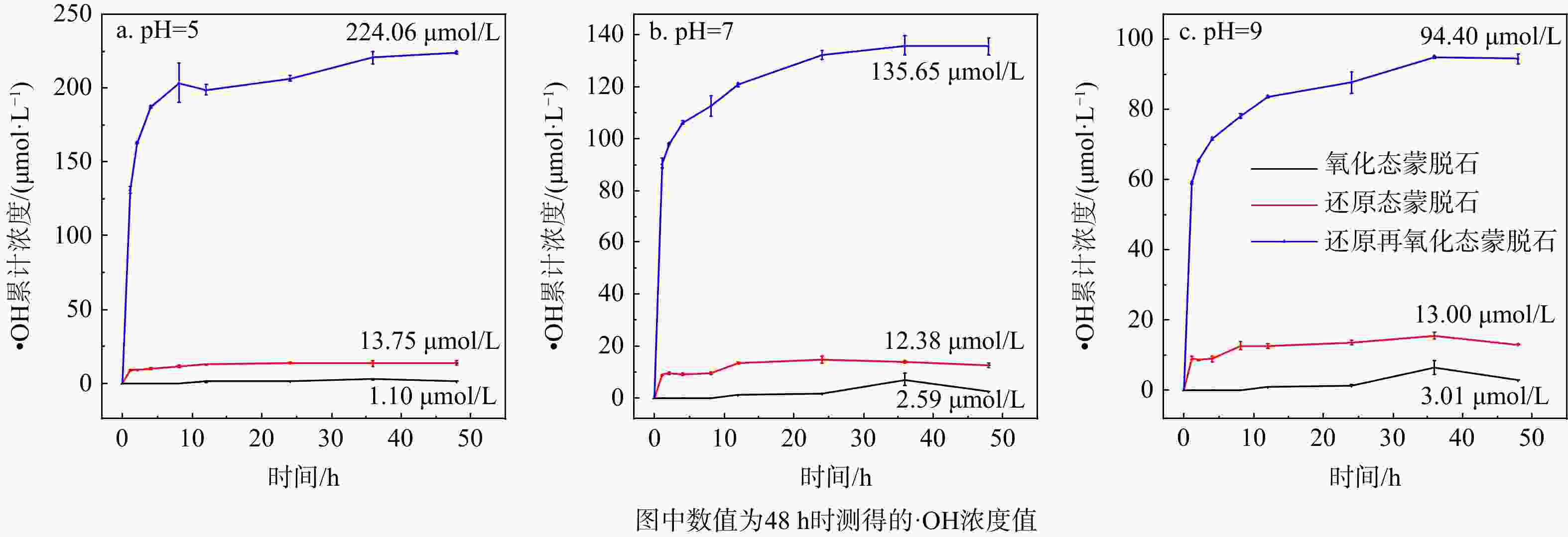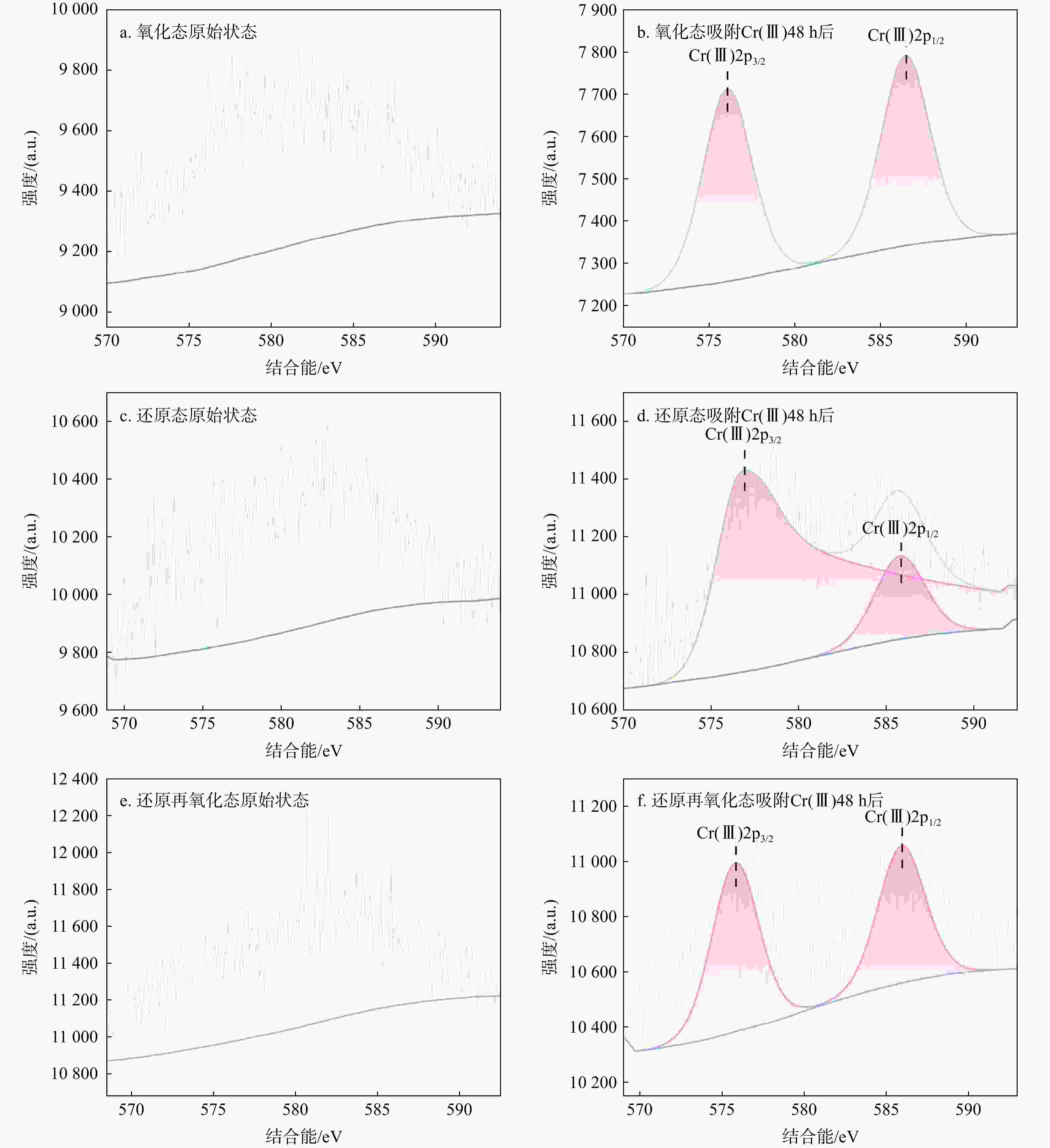-
摘要:
当环境处在氧化还原波动时,含Fe(Ⅱ)黏土矿物如何影响Cr(Ⅲ)的吸附解吸和价态转化,值得深入研究。通过制备氧化态、还原态、还原再氧化态3种不同状态的蒙脱石,对Cr(Ⅲ)进行了吸附实验,测定吸附值、Fe(Ⅱ)/总Fe、羟基自由基浓度以及价态变化,并且对吸附前后的蒙脱石固体材料进行了X射线光电子能谱(XPS)、X射线衍射(XRD)、傅里叶变换红外吸收光谱仪(FTIR)表征。结果显示,氧化态和还原态蒙脱石对Cr(Ⅲ)的吸附率随pH值的增大而增加,还原态蒙脱石吸附率最高,因为铁含量最高,这2种状态下不发生价态变化。而还原再氧化态蒙脱石的吸附率最小,是由于Fe(Ⅱ)迅速将氧气活化产生羟基自由基,Cr(Ⅲ)被迅速氧化为Cr(Ⅵ),pH值越低,氧化率越高,在8 h测得Cr(Ⅵ)又被还原性物质Fe(Ⅱ)再次还原为Cr(Ⅲ)。通过Fe(Ⅱ)/总Fe值及羟基自由基浓度变化,验证了氧化还原环境发生改变,Fe(Ⅱ)的消耗率和羟基自由基的生成率有较高的相关性。通过实验可以发现,还原再氧化后会产生羟基自由基,影响Cr(Ⅲ)的吸附解吸,并且强氧化性的羟基自由基可以氧化Cr(Ⅲ)为有毒的Cr(Ⅵ),验证了地下环境氧化还原波动后会使铬出现“返黄”的假定。
-
关键词:
- 三价铬(Cr(Ⅲ)) /
- 氧化还原 /
- 吸附解吸 /
- 羟基自由基
Abstract:Objective It is still unclear about the effects of redox fluctuations by Fe(Ⅱ)-containing clay minerals on the adsorption-desorption and valence transformation of Cr(Ⅲ).
Methods In this work, Cr(Ⅲ) adsorption experiments were carried out by preparing montmorillonite in three different conditions (oxidized, reduced, and reduced-reoxidized) to determine the adsorption value, Fe(Ⅱ)/total Fe ratio, hydroxyl radical concentration, as well as valence changes. The montmorillonite solid materials before and after adsorption were characterized via X-ray photoelectron spectroscopy (XPS), X-ray diffraction (XRD), and Fourier transform infrared (FTIR).
Results The results revealed that the adsorption rate of Cr(Ⅲ) by oxidized and reduced montmorillonite increased with elevated pH, and that reduced montmorillonite had the highest adsorption rate due to its highest Fe content, with no valence change occurring in these two states. The adsorption rate of reduced-reoxidized montmorillonite was the lowest, which was due to the rapid activation of oxygen by Fe(Ⅱ), producing hydroxyl radicals. Cr(Ⅲ) was rapidly oxidized to Cr(Ⅵ), and the lower the pH, the higher the oxidation rate. Cr(Ⅵ) was reduced back to Cr(Ⅲ) by the reducing substance Fe(Ⅱ) after 8 hours. The high correlation between the consumption rate of Fe(Ⅱ) and the generation rate of hydroxyl radicals was verified by changes in the Fe(Ⅱ)/total Fe ratio and hydroxyl radical concentration, which altered the redox environment.
Conclusion Experiments have shown that hydroxyl radicals are generated after reduction and reoxidation, which affects the adsorption and desorption of Cr(Ⅲ), and strongly oxidizing hydroxyl radicals can oxidize Cr(Ⅲ) to toxic Cr(Ⅵ), supporting the hypothesis that chromium reverts to yellowish color after redox fluctuations in the underground environment.
-
Key words:
- trivalent chromium /
- redox condition /
- adsorption resolution /
- hydroxyl radicals
-
表 1 不同pH值条件下蒙脱石对Cr(Ⅲ)的吸附率
Table 1. Adsorption rates of Cr(Ⅲ) by montmorillonite under different pH conditions
吸附率/% 蒙脱石状态 pH=5 pH=7 pH=9 氧化态 76.62 93.93 96.64 还原态 96.19 96.80 99.76 还原再氧化态 65.68 86.62 77.30 -
[1] ZHOU L,CHI T Y,ZHOU Y Y,et al. Efficient removal of hexavalent chromium through adsorption-reduction-adsorption pathway by iron-clay biochar composite prepared from Populus nigra[J]. Separation and Purification Technology,2022,285:120386. doi: 10.1016/j.seppur.2021.120386 [2] JAISHANKAR M,TSETEN T,ANBALAGAN N,et al. Toxicity,mechanism and health effects of some heavy metals[J]. Interdisciplinary Toxicology,2014,7(2):60-72. doi: 10.2478/intox-2014-0009 [3] 尹元雪,赵雨溪,孙群群,等. Cr(Ⅲ)对锰氧化菌P. putida MnB1活性及功能的影响规律与机制[J]. 地质科技通报,2024,43(1):298-305.YIN Y X,ZHAO Y X,SUN Q Q,et al. Effect of Cr(Ⅲ) on the activity and function of Mn(Ⅱ)-oxidizing bacte-r ia Pseudomonas putida MnB1[J]. Bulletin of Geological Science and Technology,2024,43(1):298-305. (in Chinese with English abstract [4] MORTADA W I,EL-NAGGAR A,MOSA A,et al. Biogeochemical behaviour and toxicology of chromium in the soil-water-human nexus:A review[J]. Chemosphere,2023,331:138804. doi: 10.1016/j.chemosphere.2023.138804 [5] BOLAN N S,ADRIANO D C,CURTIN D. Soil acidification and liming interactions with nutrientand heavy metal transformationand bioavailability[M]//Anon. Advances in agronomy. Amsterdam:Elsevier,2003:215-272. [6] CHOPPALA G,BOLAN N,KUNHIKRISHNAN A,et al. Concomitant reduction and immobilization of chromium in relation to its bioavailability in soils[J]. Environmental Science and Pollution Research International,2015,22(12):8969-8978. doi: 10.1007/s11356-013-1653-6 [7] HSU N H,WANG S L,LIN Y C,et al. Reduction of Cr(Ⅵ) by crop-residue-derived black carbon[J]. Environmental Science & Technology,2009,43(23):8801-8806. [8] SAHINKAYA E,KILIC A,ALTUN M,et al. Hexavalent chromium reduction in a sulfur reducing packed-bed bioreactor[J]. Journal of Hazardous Materials,2012,219:253-259. [9] ZHANG P,LIU J Y,YU H,et al. Kinetic models for hydroxyl radical production and contaminant removal during soil/sediment oxygenation[J]. Water Research,2023,240:120071. doi: 10.1016/j.watres.2023.120071 [10] YU H L,ZHU H T,ZHANG D F,et al. Understanding and eliminating the reductant interference on chromium Ⅵ measurement with USEPA method 3060A[J]. Science of the Total Environment,2023,879:163192. doi: 10.1016/j.scitotenv.2023.163192 [11] AYELE A,GODETO Y G. Bioremediation of chromium by microorganisms and its mechanisms related to functional groups[J]. Journal of Chemistry,2021,2021:7694157. [12] LIANG J L,HUANG X M,YAN J W,et al. A review of the formation of Cr(Ⅵ) via Cr(Ⅲ) oxidation in soils and groundwater[J]. Science of the Total Environment,2021,774:145762. doi: 10.1016/j.scitotenv.2021.145762 [13] PAN C,GIAMMAR D. Interplay of transport processes and interfacial chemistry affecting chromium reduction and reoxidation with iron and manganese[J]. Frontiers of Environmental Science & Engineering,2020,14(5):81. [14] XIE W J,YUAN S H,TONG M,et al. Contaminant degradation by ·OH during sediment oxygenation:Dependence on Fe(Ⅱ)species[J]. Environmental Science & Technology,2020,54(5):2975-2984. [15] 张子傲,刘恩涛,许家省,等. 不同国别进口铁矿石矿物学特征分析:来自显微组分和元素分析的约束[J]. 地质科技通报,2023,42(2):33-40.ZHANG Z A,LIU E T,XU J X,et al. Analysis of mineralogical characteristics of imported iron ore from different countries:Constraints from maceral compositions and elemental analysis[J]. Bulletin of Geological Science and Technology,2023,42(2):33-40. (in Chinese with English abstract [16] ZHAO J J,AL T,CHAPMAN S W,et al. Determination of Cr(Ⅲ) solids formed by reduction of Cr(Ⅵ) in a contaminated fractured bedrock aquifer:Evidence for natural attenuation of Cr(Ⅵ)[J]. Chemical Geology,2017,474:1-8. doi: 10.1016/j.chemgeo.2017.10.004 [17] DHAL B,THATOI H N,DAS N N,et al. Chemical and microbial remediation of hexavalent chromium from contaminated soil and mining/metallurgical solid waste:A review[J]. Journal of Hazardous Materials,2013,250:272-291. [18] CHEN N,FANG G D,LIU G X,et al. The degradation of diethyl phthalate by reduced smectite clays and dissolved oxygen[J]. Chemical Engineering Journal,2019,355:247-254. doi: 10.1016/j.cej.2018.08.160 [19] SCHAEFER C E,HO P,BERNS E,et al. Mechanisms for abiotic dechlorination of trichloroethene by ferrous minerals under oxic and anoxic conditions in natural sediments[J]. Environmental Science & Technology,2018,52(23):13747-13755. [20] TONG M,YUAN S H,MA S C,et al. Production of abundant hydroxyl radicals from oxygenation of subsurface sediments[J]. Environmental Science & Technology,2016,50(1):214-221. [21] XIE W J,ZHANG P,LIAO W J,et al. Ligand-enhanced electron utilization for trichloroethylene degradation by ·OH during sediment oxygenation[J]. Environmental Science & Technology,2021,55(10):7044-7051. [22] 袁铎恩,边家辉,刘紫璇,等. 华北板块南缘早二叠世煤中微量元素赋存特征及主控机制[J]. 地质科技通报,2023,42(5):138-149.YUAN D E,BIAN J H,LIU Z X,et al. Occurrence characteristics and main control mechanism of trace elements in Early Permian coal in the southern margin of North China Plate[J]. Bulletin of Geological Science and Technology,2023,42(5):138-149. (in Chinese with English abstract [23] CHANG J J,ZHANG J,WANG H,et al. Cr(Ⅵ) adsorption and reduction by magnetite-humic acid adsorption complexes under mildly acidic conditions:Synergistic/antagonistic mechanism and multi-step reaction model[J]. Chemical Engineering Journal,2023,451:138648. doi: 10.1016/j.cej.2022.138648 [24] LI Y,LIU J R,JIA S Y,et al. TiO2 pillared montmorillonite as a photoactive adsorbent of arsenic under UV irradiation[J]. Chemical Engineering Journal,2012,191:66-74. doi: 10.1016/j.cej.2012.02.058 [25] IJAGBEMI C O,BAEK M H,KIM D S. Montmorillonite surface properties and sorption characteristics for heavy metal removal from aqueous solutions[J]. Journal of Hazardous Materials,2009,166(1):538-546. doi: 10.1016/j.jhazmat.2008.11.085 [26] DOGAN M,DOGAN A U,YESILYURT F I,et al. Baseline studies of the clay minerals society special clays:Specific surface area by the Brunauer Emmett Teller (BET) method[J]. Clays and Clay Minerals,2007,55(5):534-541. doi: 10.1346/CCMN.2007.0550508 [27] WANG T,ZHAO D Y,CAO J,et al. FeS-mediated mobilization and immobilization of Cr(Ⅲ) in oxic aquatic systems[J]. Water Research,2022,211:118077. doi: 10.1016/j.watres.2022.118077 [28] GAO S J,CAO W D,GAO J S,et al. Effects of long-term application of different green manures on ferric iron reduction in a red paddy soil in southern China[J]. Journal of Integrative Agriculture,2017,16(4):959-966. doi: 10.1016/S2095-3119(16)61509-5 [29] HAI J,LIU L H,TAN W F,et al. Catalytic oxidation and adsorption of Cr(Ⅲ) on iron-manganese nodules under oxic conditions[J]. Journal of Hazardous Materials,2020,390:122166. doi: 10.1016/j.jhazmat.2020.122166 [30] XU T,NAN F,JIANG X F,et al. Effect of soil pH on the transport,fractionation,and oxidation of chromium(Ⅲ)[J]. Ecotoxicology and Environmental Safety,2020,195:110459. doi: 10.1016/j.ecoenv.2020.110459 [31] LI Q,ZHANG X M,ZHENG J H,et al. Phase transformation of Cr(Ⅵ) host-mineral driven by citric acid-aided mechanochemical approach for advanced remediation of chromium ore processing residue-contaminated soil[J]. Journal of Hazardous Materials,2024,461:132530. doi: 10.1016/j.jhazmat.2023.132530 [32] LIU C R,LIU Y,SHEN W T,et al. Unveiling the interaction mechanism between facet-dependent pyrite nanoparticles and Cr(Ⅵ) under anaerobic environment:Adsorption,redox,and phase transformation[J]. Chemical Engineering Journal,2023,459:141586. doi: 10.1016/j.cej.2023.141586 [33] PETIT S,BARON F,GRAUBY O,et al. Revisiting the cation mass-valence sum approach to assigning infrared OH- bands in dioctahedral smectites in the light of new data from synthetic Ga-Fe3+ smectites[J]. Vibrational Spectroscopy,2016,87:137-142. doi: 10.1016/j.vibspec.2016.09.022 [34] ZHAO L D,DONG H L,KUKKADAPU R K,et al. Biological redox cycling of iron in nontronite and its potential application in nitrate removal[J]. Environmental Science & Technology,2015,49(9):5493-5501. [35] DRITS V A,MCCARTY D K,ZviAGINA B B. Crystal-chemical factors responsible for the distribution of octahedral cations over trans- and cis-sites in dioctahedral 2:1 layer silicates[J]. Clays and Clay Minerals,2006,54(2):131-152. doi: 10.1346/CCMN.2006.0540201 [36] WOLTERS F,LAGALY G,KAHR G,et al. A comprehensive characterization of dioctahedral smectites[J]. Clays and Clay Minerals,2009,57(1):115-133. doi: 10.1346/CCMN.2009.0570111 [37] DRITS V A,MANCEAU A. A model for the mechanism of Fe3+ to Fe2+ reduction in dioctahedral smectites[J]. Clays and Clay Minerals,2000,48(2):185-195. doi: 10.1346/CCMN.2000.0480204 [38] FIALIPS C I,HUO D F,YAN L B,et al. Effect of Fe oxidation state on the IR spectra of Garfield nontronite[J]. American Mineralogist,2002,87(5/6):630-641. [39] NEUMANN A,PETIT S,HOFSTETTER T B. Evaluation of redox-active iron sites in smectites using middle and near infrared spectroscopy[J]. Geochimica et Cosmochimica Acta,2011,75(9):2336-2355. doi: 10.1016/j.gca.2011.02.009 [40] MADEJOVÁ J. FTIR techniques in clay mineral studies[J]. Vibrational Spectroscopy,2003,31(1):1-10. doi: 10.1016/S0924-2031(02)00065-6 [41] YAN L B,STUCKI J W. Structural perturbations in the solid-water interface of redox transformed nontronite[J]. Journal of Colloid and Interface Science,2000,225(2):429-439. doi: 10.1006/jcis.2000.6794 [42] ROSE A L,WAITE T D. Kinetic model for Fe(Ⅱ) oxidation in seawater in the absence and presence of natural organic matter[J]. Environmental Science & Technology,2002,36(3):433-444. [43] LIU W Z,LI J,ZHENG J Y,et al. Different pathways for Cr(Ⅲ) oxidation:Implications for Cr(Ⅵ) reoccurrence in reduced chromite ore processing residue[J]. Environmental Science & Technology,2020,54(19):11971-11979. [44] SCHINDLER M,LUSSIER A J,PRINCIPE E,et al. Dissolution mechanisms of chromitite:Understanding the release and fate of chromium in the environment[J]. American Mineralogist,2018,103(2):271-283. doi: 10.2138/am-2018-6234 [45] WADHAWAN A R,LIvi K J,STONE A T,et al. Influence of oxygenation on chromium redox reactions with manganese sulfide (MnS(s))[J]. Environmental Science & Technology,2015,49(6):3523-3531. [46] BARTLETT R J,JAMES B. Behavior of chromium in soils:Ⅲ. Oxidation[J]. Journal of Environmental Quality,1979,8:31-35. [47] ZHANG W F,ZHANG P X,LIU F,et al. Simultaneous oxidation of Cr(Ⅲ) and extraction of Cr(Ⅵ) from chromite ore processing residue by silicate-assisted hydrothermal treatment[J]. Chemical Engineering Journal,2019,371:565-574. doi: 10.1016/j.cej.2019.04.082 -





 下载:
下载:

